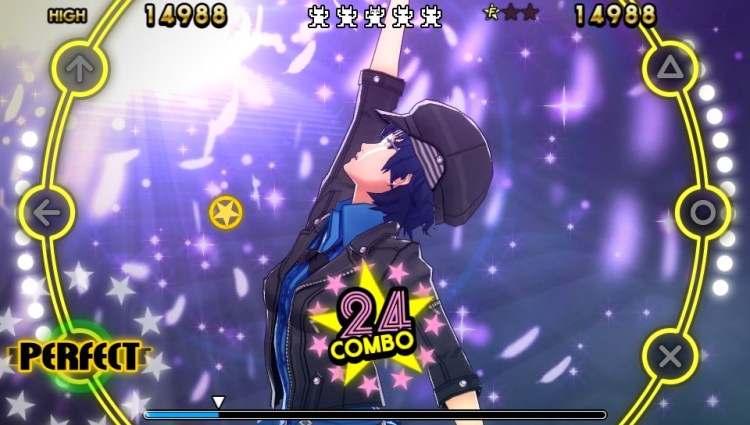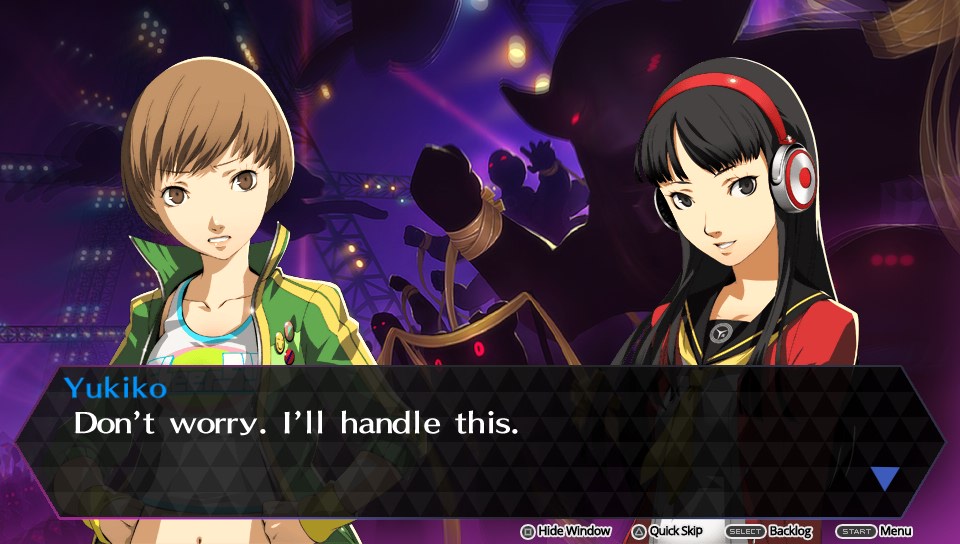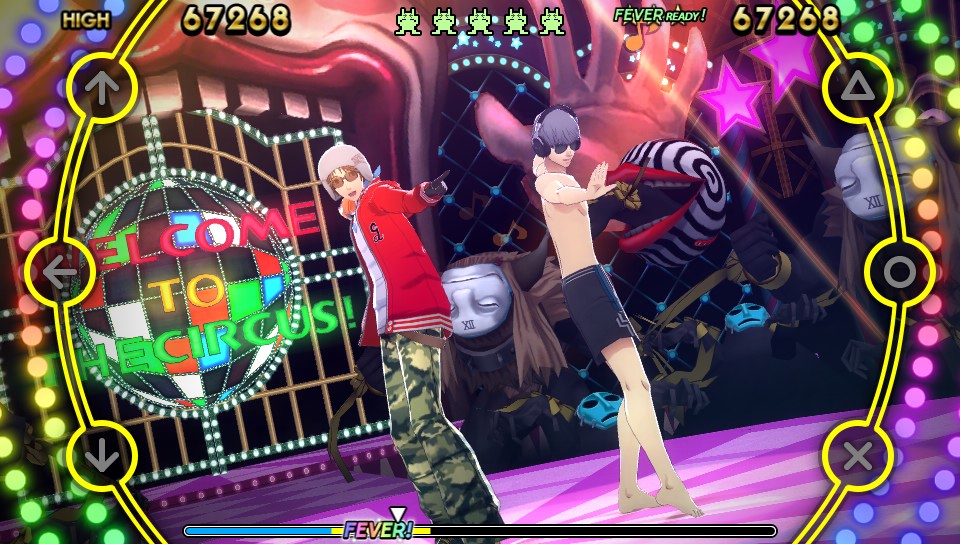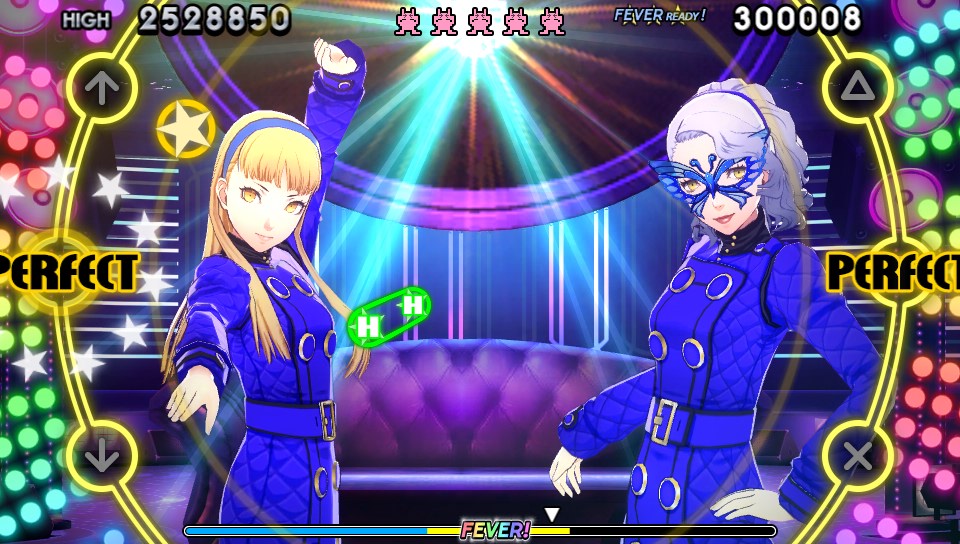If there’s one thing the Persona series has proven, it is the versatility of exuberant youth.
Developer and publisher Atlus releases its rhythm-action Persona 4 spin-off, Persona 4: Dancing All Night on September 29 on PlayStation Vita. A non-RPG spin-off from a RPG series isn’t anything new; just look at the Final Fantasy franchise. For Persona (which itself is a spin-off of the Shin Megami Tensei series), it’s not a question of whether it was deserving of another sidetrip but what genres would make sense for this well-praised Japanese RPG. And when you have a cast of young adults brimming with ardor, a fighting game (Persona 4 Arena) would make as much sense as a dungeon crawler (Persona Q: Shadow of the Labyrinth). It even makes more sense to imagine the Persona 4 universe in the context of a rhythm action game, especially since one of its key characters Rise Kujikawa is an idol singer. It wouldn’t be that far-fetched that her close friends would join in with their own dancing talents.
What you’ll like
The gang is back together
Between the calm, cool, and collected leadership of Yu Narukami and the infectious charisma of Chie Satonaka, it’s no surprise that this special ensemble has worked so well (even with their adolescent insecurities and other teenager issues). It’s a joy to see them return as a complete cast in Persona 4: Dancing All Night. As much as this serves as an excuse to watch this lovable gang dance, it isn’t a simple case of transposing preexisting character models into a rhythm action game; it also has story to tell. The junior idol group associated with Rise has gone missing, and she is looking to her friends for help in the search. Much like Persona 4, Yu and friends investigate with the energy and assertiveness of a Japanese Scooby-Doo gang (minus the snack binges and cowardly chases).
Abundance of stimulating rhythm action
In 2015, any rhythm-action enthusiast should expect that any new entry will have its own unique interface, however novel or practical in order to set itself apart from what is already out there. Emulating scrolling arrows in the style of DDR or rail-riding in Guitar Hero would just be plain lazy. Persona 4: Dancing All Night does in fact excel for having its own standout UI. It’s no surprise that the basic controls are deceptively simple: Commands fly outward from the center of the screen, and you’re tasked to press one of three directional commands or three shape button inputs as the icons reach the edge of the display. The advanced challenges are equally traditional: You have to hit two buttons at the same time, and some inputs have to be held for a sustained note. It’s standard issue rhythm action.
Check out our Reviews Vault for past game reviews.
The curveballs come from two areas. The first is a bonus ring that also flies from the center of the screen. If you flick either analog stick as the ring reaches the edge of the screen, you’ll increase your chances of added perks, such as a dance duet with another character. The second obstacle is the vibrant backgrounds. Persona 4’s excellence in art direction is in full display, and having its cast dance for you while you’re trying to hit the notes is a bona fide distraction.
Melody over beats
When it comes to the recent availability of Japanese-developed rhythm action games published in the West, the Hatsune Miku series has dominated the space for the last 24 months. The infectiousness of many of that franchise’s songs is real, but just because music is infectious doesn’t necessarily make it pleasing. That’s especially the case when many Hatsune Miku tracks are mostly high on treble, rely too much on repetition, and exceed 180 beats per minute. Dancing All Night isn’t devoid of these kinds of compositions, but it does have fewer of them. While the curmudgeon in me longs for a return to the audibly pleasing songs from Avex Trax’s artists in Bust-A-Move (Bust-A-Groove in the U.S.), I am happy to settle for the diverse selection of dance genres in Persona 4: Dancing All Night. Tolerating a song that plays 200 bpm is easy when the same playlist has a generous helping of tracks with saxophone accompaniments.
What you won’t like
Wide difficulty gap
By their design, practically every rhythm action game is both a paradise and a nightmare for perfectionists. Whether it’s Guitar Hero or Rhythm Heaven Fever, the hardcore fans strive to master stages with 100 percent perfection. You can hope to achieve similar goals in Persona 4: Dancing All Night. Progressing from songs at the Easy level to Normal feels sensible as more complex inputs are added to the latter mode. Going from Normal to Hard is a completely different beast. “Specialist,” one of the first songs led by Yu, took me one attempt to clear on Normal whereas I needed 20 attempts on Hard. I typically find a lot of gratification in conquering the new layer of challenges that comes with every difficulty bump. I do not disagree that Hard is indeed hard, but I think this game could benefit from another setting in between Normal and Hard.
If it’s of any consolation, it’s comforting that for every attempt at any difficulty level yields in-game currency that can be spent on the game’s myriad outfits and accessories. I normally don’t find a lot of value in accessorizing my characters but when it comes to image-conscious teens, let alone those who live in a cosmopolitan part of Japan, it’s easy to feel motivated to expand these kids’ wardrobes.
A great deal of reading
Persona fans come to the series for various reasons, whether it is the appeal of the youthful cast or how the contemporary setting is a welcome break from fantasy and sci-fi RPG. For some, the draw of Persona is its generous dialogue and exposition, further evidenced by the gradual rise of interest in Japanese visual novels in the West. If you’re used to this, you’re in for a treat; not only is there an abundance of text to read, but it’s heavily supported by English voice acting. If you’re not used to a lot of reading in your games but can’t get enough of rhythm action, the Quick Skip option will move you along to the next song.
Conclusion
The ideal entry point for any Persona 4 newcomer (and the franchise as a whole) should be the PlayStation Vita enhanced remake, Persona 4 Golden. Yet if you cannot foresee making a 70 hour commitment to that JRPG, Persona 4: Dancing All Night is more than suitable as a gateway experience to the series. It’s themes on teen angst and the value of friendship are in line with the main game, more so than the fantastical Persona Q or the outlandish Persona 4 Arena. It’s not without its tough challenges, but any superb game in this genre should be demanding. As one of the better and more charming rhythm action games to come out in recent years, Persona 4: Dancing All Night is not only an apt and engrossing spin-off, but it’s an effective side story that will help pass the time while we impatiently wait for Persona 5.
Score: 88/100
Persona 4: Dancing All Night is available for PlayStation Vita on September 29. Atlus provided GamesBeat with a review copy of the game for the purposes of this review.
VentureBeat's mission is to be a digital town square for technical decision-makers to gain knowledge about transformative enterprise technology and transact. Learn More




